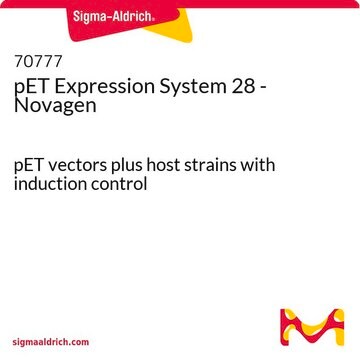70235-M
BL21(DE3) Singles Competent Cells - Novagen
Escherichia coli, rod shaped
Synonym(s):
BL21 strain
About This Item
Recommended Products
product name
BL21(DE3) Singles Competent Cells - Novagen, BL21(DE3) is a chemically competent E. coli cell suitable for transformation and high level protein expression using a T7 RNA polymerase-IPTG induction system.
biological source
Escherichia coli
Quality Level
manufacturer/tradename
Novagen®
storage condition
OK to freeze
avoid repeated freeze/thaw cycles
growth mode
adherent or suspension
morphology
rod shaped
technique(s)
microbiological culture: suitable
cell transformation
transformation efficiency: >2×107 cfu/μg
shipped in
dry ice
storage temp.
−70°C
General description
This product contains genetically modified organisms (GMO). Within the EU GMOs are regulated by Directives 2001/18/EC and 2009/41/EC of the European Parliament and of the Council and their national implementation in the member States respectively. This legislation obliges us to request certain information about you and the establishment where the GMOs are being handled. Click here for Enduser Declaration (EUD) Form.
T7 expression strains are lysogens of bacteriophageDE3, as indicated by the (DE3). These hosts carry achromosomal copy of the T7 RNA polymerase gene under control of the lacUV5 promoter. Such strains are suitable for production of protein from target genes cloned in appropriate T7 expression vectors, using IPTG as an inducer.
BL21 has been the gold standard for protein expression since it was first introduced in 1990. Deficient in lon and ompT proteases, BL21 and its derivatives are ideal for many applications.
Components
Warning
DNA Profile
Legal Information
Certificates of Analysis (COA)
Search for Certificates of Analysis (COA) by entering the products Lot/Batch Number. Lot and Batch Numbers can be found on a product’s label following the words ‘Lot’ or ‘Batch’.
Already Own This Product?
Find documentation for the products that you have recently purchased in the Document Library.
Our team of scientists has experience in all areas of research including Life Science, Material Science, Chemical Synthesis, Chromatography, Analytical and many others.
Contact Technical Service



